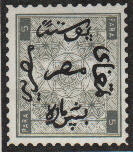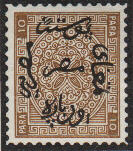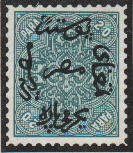Do you remember? At the beginning we talked about Missr, just what you call "Egypt" :
![]()
![]() r - ss - m, written from the right to the left.
r - ss - m, written from the right to the left.
Here I want to present you the oldest egyptian stamps from 1866
with subsequent reading exercises.
 |
 |
 |
 |
 |
 |
 |
 |
| besch (5) Parah | aun (on=10) Parah | ikrmi (jirmi=20) Parah | ikij (2) Krusch |
Reading exercise: please note where the three points of the "p" can appear !
A new letter is the "u" that can also be used as an "o" and a "w":
In 1866 Egypt was a province of the Ottoman Empire. The writing on the stamp states its value in Para or Kurusch, additional to this is written in old-turk language:
"Tamga pusta missrija", meaning "Stamp of (the) Post Egyptian"
and additional in the middle: "Missr".
| 1) | ||||
| 2) | ||||
| 3) | i-a-g-m-t | ah-t-s-u-p | ija-r-ss-m | r-ss-m |
| 4) | t(a)mga | pusta | m(i)ssrija | M(i)ssr |
| 5) | stamp | post | egyptian | Egypt |
2) in standardized writing (see my essay about writing styles "Schriftkunde" )
3) all letters, but without the short vowels
4) roughly the pronounciation
5) translation
In a handwritten text you often see letters on top of each other.
This is just to fill out the "empty space", to fit the arabic ideal of beauty.
Wordendings have their own rules. Just think of the word "through" what could be written "thru" (well, I think it is actually in american english). Here you see the arabic wordendings
"-i" , "-ah" and "-ija" written in different manner.
Please do not expect any logic in these rules...

the turk written numerals also show two unusual spellings :
sounds "on" written "aun", sounds "ji- " written "jk-".
Note as well that in the word "jirmi the "m" is OVER the "i"
The blue marked hook emphasises the "u", is just a readingaid.
| 1) |  |
 |
 |
 |
| 2) |  |
 |
 |
 |
| 3) | hrap sch-b | hrap nua | hrap imrkj | sch-urg ikia |
| 4) | b(e)sch Par(a) | on Par(a) | jirmi Par(a) | ikij K(u)rusch |
| 5) | 5 Para | 10 Para | 20 Para | 2 "Piaster" |
2) in standardized writing
3) all letters, but without the short vowels
4) roughly the pronounciation
5) translation

Indeed I hope, now you know well the following letters : a, b, d, i, l, m, n, N, p, r, s, ss, t, u, w.
If not, you should repeat the whole exercise !
On the next page we'll put it into practice: the complete alphabet is awaiting you !